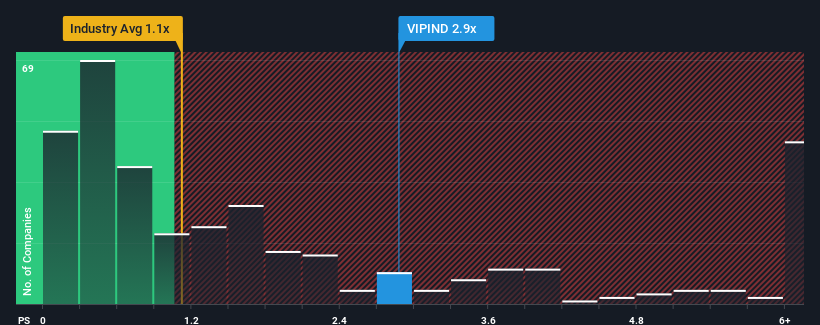V.I.P. Industries Limited's (NSE:VIPIND) Business Is Yet to Catch Up With Its Share Price
When close to half the companies in the Luxury industry in India have price-to-sales ratios (or "P/S") below 1.1x, you may consider V.I.P. Industries Limited (NSE:VIPIND) as a stock to potentially avoid with its 2.9x P/S ratio. Although, it's not wise to just take the P/S at face value as there may be an explanation why it's as high as it is.
Check out our latest analysis for V.I.P. Industries

How Has V.I.P. Industries Performed Recently?
V.I.P. Industries could be doing better as it's been growing revenue less than most other companies lately. One possibility is that the P/S ratio is high because investors think this lacklustre revenue performance will improve markedly. You'd really hope so, otherwise you're paying a pretty hefty price for no particular reason.
If you'd like to see what analysts are forecasting going forward, you should check out our free report on V.I.P. Industries.What Are Revenue Growth Metrics Telling Us About The High P/S?
In order to justify its P/S ratio, V.I.P. Industries would need to produce impressive growth in excess of the industry.
If we review the last year of revenue growth, the company posted a worthy increase of 4.0%. This was backed up an excellent period prior to see revenue up by 122% in total over the last three years. So we can start by confirming that the company has done a great job of growing revenues over that time.
Looking ahead now, revenue is anticipated to climb by 11% each year during the coming three years according to the eleven analysts following the company. Meanwhile, the rest of the industry is forecast to expand by 14% per year, which is noticeably more attractive.
In light of this, it's alarming that V.I.P. Industries' P/S sits above the majority of other companies. Apparently many investors in the company are way more bullish than analysts indicate and aren't willing to let go of their stock at any price. Only the boldest would assume these prices are sustainable as this level of revenue growth is likely to weigh heavily on the share price eventually.
The Key Takeaway
Using the price-to-sales ratio alone to determine if you should sell your stock isn't sensible, however it can be a practical guide to the company's future prospects.
It comes as a surprise to see V.I.P. Industries trade at such a high P/S given the revenue forecasts look less than stellar. The weakness in the company's revenue estimate doesn't bode well for the elevated P/S, which could take a fall if the revenue sentiment doesn't improve. Unless these conditions improve markedly, it's very challenging to accept these prices as being reasonable.
Having said that, be aware V.I.P. Industries is showing 1 warning sign in our investment analysis, you should know about.
It's important to make sure you look for a great company, not just the first idea you come across. So if growing profitability aligns with your idea of a great company, take a peek at this free list of interesting companies with strong recent earnings growth (and a low P/E).
New: Manage All Your Stock Portfolios in One Place
We've created the ultimate portfolio companion for stock investors, and it's free.
• Connect an unlimited number of Portfolios and see your total in one currency
• Be alerted to new Warning Signs or Risks via email or mobile
• Track the Fair Value of your stocks
Have feedback on this article? Concerned about the content? Get in touch with us directly. Alternatively, email editorial-team (at) simplywallst.com.
This article by Simply Wall St is general in nature. We provide commentary based on historical data and analyst forecasts only using an unbiased methodology and our articles are not intended to be financial advice. It does not constitute a recommendation to buy or sell any stock, and does not take account of your objectives, or your financial situation. We aim to bring you long-term focused analysis driven by fundamental data. Note that our analysis may not factor in the latest price-sensitive company announcements or qualitative material. Simply Wall St has no position in any stocks mentioned.
About NSEI:VIPIND
V.I.P. Industries
Manufactures and retails luggage, backpacks, handbags, and accessories in India and internationally.
Reasonable growth potential with mediocre balance sheet.
Similar Companies
Market Insights
Community Narratives




